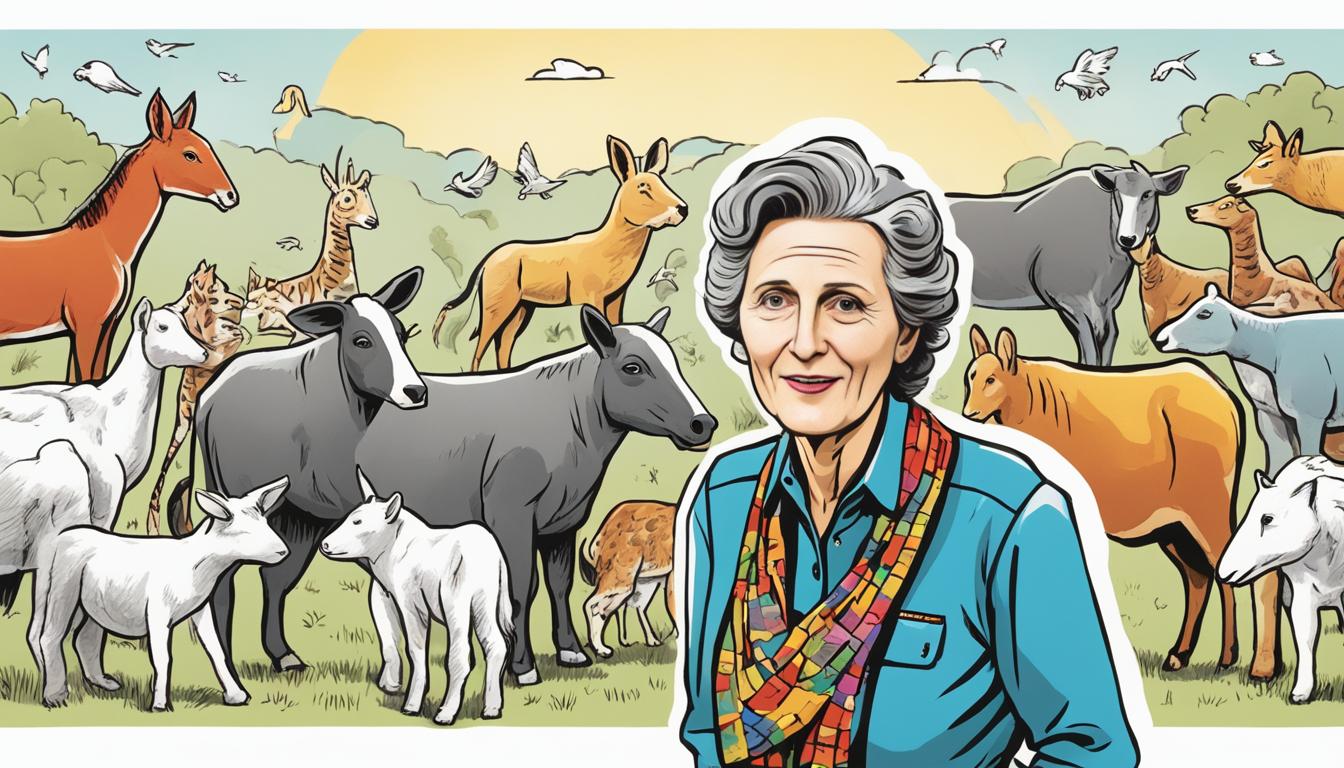Animal behavior has long been a topic of fascination for scientists and enthusiasts alike. Yet the inner workings of the animal mind remain elusive. In her book “Animals in Translation,” Temple Grandin offers a unique perspective on this elusive topic. With her expertise in autism and animal behavior, Grandin provides a groundbreaking exploration of the connection between the two.
In this article, we will examine “Animals in Translation” in depth, highlighting its key themes, case studies, and insights. We will also explore Grandin’s background and approach as well as the practical applications and ethical considerations of her research. Finally, we will discuss the impact of Grandin’s work on animal behavior studies and her lasting influence in the field.
So, join us as we dive into the world of animal behavior through the lens of autism with “Animals in Translation.”
Overview of the Book
“Animals in Translation” is a fascinating exploration of the connection between animal behavior and autism. Written by Temple Grandin, a renowned expert in both fields, the book offers unique insights into the minds and behaviors of animals, drawing upon Grandin’s own experiences as an individual with autism.
The book is divided into ten chapters, each of which focuses on a specific aspect of animal behavior and autism. Throughout the book, Grandin emphasizes the many similarities between animals and individuals with autism, building a compelling case for using this often-misunderstood condition as a tool for understanding and decoding animal behavior.
In “Animals in Translation,” readers will explore topics such as animal emotions, sensory experiences, and social behavior, gaining a deeper understanding of the complex world of animal communication and interaction. Through a combination of case studies, personal anecdotes, and scientific research, Grandin offers a comprehensive overview of the fascinating and often-misunderstood world of animal behavior and autism.
Temple Grandin’s Background and Approach
Temple Grandin is a renowned author, animal behaviorist, and professor of animal science at Colorado State University. Having been diagnosed with autism at a young age, Grandin brings a unique perspective to her work, providing insights into animal behavior that others may overlook.
Grandin’s approach to animal behavior is grounded in her understanding of how her own mind works, which she has described as being similar to how animals perceive the world. This perspective has allowed her to develop innovative approaches to animal handling and welfare, which have been widely adopted in the industry.
Grandin has written extensively on animal behavior, autism, and their intersection. Her book “Animals in Translation” provides invaluable insights into how animals perceive the world and behave in response to various stimuli, which can help improve animal training and welfare practices.
Overall, Temple Grandin’s unique background and approach have enabled her to make significant contributions to our understanding of animal behavior, which continue to impact the field today.
Autism and Animal Behavior
Temple Grandin’s unique perspective as an individual with autism has allowed her to identify compelling parallels between autism and animal behavior. In Animals in Translation, she explains how her own challenges with sensory processing enabled her to recognize similar challenges in animals, which in turn has aided her in decoding their behavior.
One key similarity between autism and animal behavior is a heightened sensitivity to sensory stimuli. Grandin notes that many animals are easily overwhelmed by sensory information, much like individuals with autism. For example, a dog may be unable to focus on a command if there are too many distracting smells or sounds in the environment. By recognizing this, trainers can modify their techniques to avoid overwhelming the animal and ensure that they are better able to focus on the task at hand.

Another similarity is difficulty with social communication, which can manifest in various ways in both animals and individuals with autism. For example, just as humans with autism may struggle to interpret facial expressions or body language, dogs may misinterpret an owner’s signals if they are not clearly communicating their intentions.
By drawing on her own experiences with autism, Grandin has been able to develop innovative techniques for interpreting animal behavior and improving their welfare. Through continued research and collaboration with other experts, she hopes to unlock even more insights into the fascinating and complex world of animal behavior.
Case Studies and Insights
In “Animals in Translation,” Temple Grandin presents several case studies that shed light on animal behavior and its interpretation through the lens of autism. One case study focuses on the behavior of cattle in a feedlot, demonstrating how a simple change in color can significantly impact how the animals respond. Another case study examines the behavior of wild horses, highlighting how their social interactions contribute to their overall well-being.
In addition to these case studies, Grandin provides insights into the unique sensory experiences of animals, such as their sensitivity to light and sound. By utilizing this knowledge, animal handlers can create more comfortable and stress-free environments for the animals they care for.
Through her research and first-hand experience, Temple Grandin provides valuable insights into the world of animal behavior and highlights the importance of understanding and interpreting their actions.
Practical Applications
Temple Grandin’s research and insights into animal behavior interpretation have important practical applications in various fields, including animal training and welfare.
One of the most significant practical uses of Grandin’s work is in improving animal welfare. By understanding and interpreting animal behavior through an autistic lens, her methods have helped to identify and address the specific needs of animals in captivity. For example, her insights into cattle behavior have led to the design of more humane slaughterhouses, reducing stress and pain for the animals.
Grandin’s methods have also proven useful in animal training, particularly in the horse racing industry. Her approach to understanding equine behavior has led to the development of more effective training methods, improving the performance and wellbeing of racehorses.
“My experience with animals has taught me that autistic thinking and animal thinking have striking similarities, such as a tendency to think in pictures rather than words.” – Temple Grandin
Ethical Considerations
Using autism as a tool to interpret and understand animal behavior raises various ethical considerations in terms of both animal welfare and human values. One concern is the potential for misinterpretation or overly simplistic analyses of animal behavior, which may lead to inaccurate assumptions and inappropriate interventions. Another issue is the potential for harm to animals during experiments or training programs. It is therefore essential to ensure that any research or application of animal behavior interpretation methods is conducted with the utmost care and respect for the well-being of animals and their natural habitats.
On the other hand, animal behavior interpretation can also provide valuable insights into animal cognition and emotions, allowing for improved animal welfare and understanding of ethical considerations for animals in various settings. For example, interpreting the behavior of captive animals can aid in the development of enrichment programs that improve both the mental and physical health of animals in captivity. Additionally, an understanding of animal behavior may inform better agricultural practices, such as providing animals with ample space and access to natural habitats.
In summary, while animal behavior interpretation through the lens of autism can offer significant benefits, it must be approached with caution and ethical considerations. It is our responsibility to protect animal welfare and to respect the dignity and complexity of animals’ lives while seeking a better understanding of their behavior.

Critiques and Controversies
While Temple Grandin’s approach has gained widespread recognition and praise for its unique perspective, it’s not without criticisms and controversies. Some experts have raised concerns about the reliability of extrapolating autism-related insights to all animal behavior, as well as the potential oversimplification of animal behavior by only considering autistic tendencies. However, Grandin has addressed these critiques by emphasizing the importance of looking at individual animals and using a nuanced approach that considers both autism and other factors that influence animal behavior.
Another area of controversy relates to the limitations of using animal behavior interpretation to inform ethical decisions. Some have argued that relying too heavily on autistic insights can oversimplify complex ethical considerations, potentially leading to flawed decision-making. However, others believe that Grandin’s research provides valuable insights into animal welfare and can help inform ethical decision-making in a variety of contexts.
Influence and Legacy
Temple Grandin’s impact on the study of animal behavior and welfare cannot be overstated. Her insights and innovative approaches have shaped the field since the publication of “Animals in Translation” in 2005.
Grandin’s focus on the sensory experiences of animals served as a critical framework for their understanding, shaping the development of more humane handling and care. Her work has influenced best practices across the industry, creating lasting change and advancing the field.
Grandin’s teaching and mentorship have also inspired and encouraged young researchers to pursue the field of animal behavior studies, ensuring her legacy as a force for good continues to grow.
Grandin’s Contributions to Animal Behavioral Studies
| Impact | Details |
|---|---|
| Revolutionizing Slaughterhouse Practices | After her research on cattle behavior, Temple Grandin created a system for humane slaughter, which has been widely adopted. |
| Improving Housing and Handling | Grandin’s insights helped create more spacious and comfortable living conditions for livestock, reducing stress and improving their well-being. |
| Bridging Science and Practice | Grandin’s research seamlessly integrated cutting-edge research insights with real-life industry demands, shaping best practices across the industry. |
Inspiring Future Generations
Grandin’s contributions to animal behavior studies have inspired a new generation of researchers, ensuring a hopeful future for animal welfare. Her books – which include “Animals Make Us Human” and “Thinking in Pictures” – have become the go-to resources for understanding animal behavior.
Moreover, Grandin’s autism advocacy and her journey have made her a role model for people living with autism, providing a beacon of hope and inspiration for individuals facing similar challenges.
“Animals are not just sentient beings but thinking ones.”
Temple Grandin’s empathy and understanding of animal behavior has revolutionized the field of animal welfare, opening up new ways of thinking, understanding, and improving the lives of animals. Her enduring influence, compassion and insights will continue to inspire generations to come.
Conclusion
Temple Grandin’s “Animals in Translation” provides a unique and insightful exploration of the mysteries of animal behavior through the lens of autism. The key takeaway from the book is the remarkable similarities between the challenges faced by individuals with autism and animals, which can be decoded and understood using similar principles.
Grandin’s expertise in animal behavior, combined with her personal experience with autism, offers a fascinating perspective on the way animals perceive and interact with the world around them. The case studies presented in the book provide deep insights into animal behavior and offer new ways of interpreting their actions and needs.
The practical applications of Grandin’s research are vast, as her methods can be used in various fields such as animal training and welfare. However, ethical considerations must be taken into account when using autism as a tool to understand animal behavior. While there is controversy surrounding Grandin’s approach, her work has undoubtedly influenced the field of animal behavior studies and inspired future research.
Overall, “Animals in Translation” is a fascinating book that sheds light on the complexities of animal behavior and provides valuable insights for anyone interested in animal welfare, training, and understanding. Grandin’s legacy will undoubtedly continue to shape the field of animal behavior studies for years to come.



